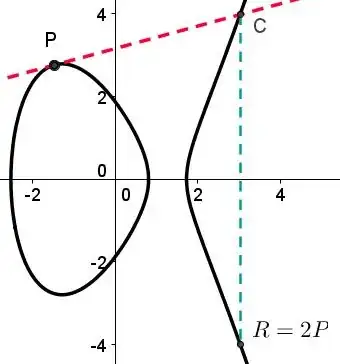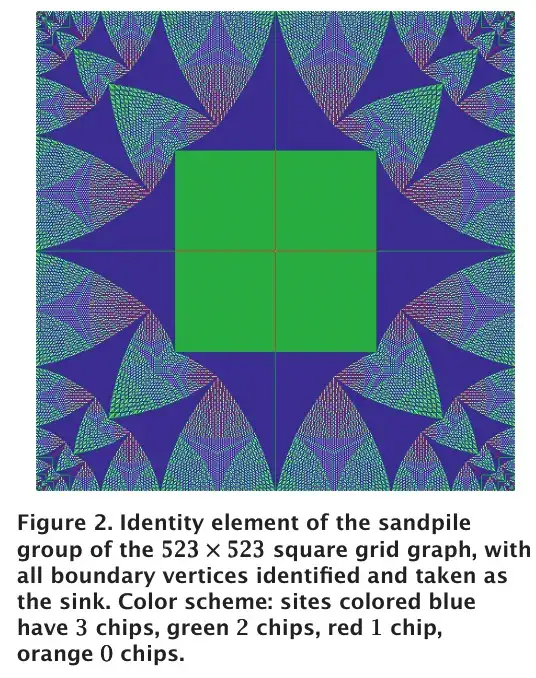1- Fourier analysis: the set of non-vanishing absolutely convergent Fourier series is a group under pointwise multiplication.
The neutral element is the constant function equal to $1$. And product stability follows from Cauchy product. These are straightforward. The existence of inverses is less obvious.
Wiener's lemma: if $f(t)=\sum_{\mathbb{Z}}c_ne^{int}$ is absolutely convergent, i.e. $\sum_{\mathbb{Z}}|c_n|<\infty$, and does not vanish, then $\frac{1}{f(t)}$ is also the sum of an absolutely convergent Fourier series.
This is not that hard either. But it was, and remains, striking. You can find a proof here. Less elementary, but much more interesting, the proof given by Gelfand which raised the interest in Banach algebras. Indeed, the absolutely convergent Fourier series form a unital commutative Banach algebra with spectrum $[0,2\pi]$. More precisely, the characters are the point evaluations $f\longmapsto f(t_0)$. The invertibility of non-vanishing elements is then obvious via Gelfand representation.
2- von Neumann algebras: for a type $\rm{II}_1$ factor von Neumann algebra $M$, i.e. an infinite-dimensional noncommutative probability space, we can make sense of $t\times t$ matrices over $M$ for every real $t>0$. This gives rise to another type $\rm{II}_1$ factor $M^t$.
In their seminal work dating back to the 1930's, Murray and von Neumann introduced the fundamental group of a $\rm{II}_1$ factor $M$
$$
\mathcal{F}(M):=\{t>0\;;\;M^t\simeq M\}.
$$
It is not hard, but not obvious per se, to see that this is a subgroup of $(\mathbb{R}^+,\;\cdot\;)$.
One of their striking classification results says that, up to isomorphism, there exists a unique approximately finite-dimensional type $\rm{II}_1$ factor $R$. As a consequence, it follows that
$$
\mathcal{F}(R)=\mathbb{R}^+.
$$
By Connes' groundbreaking work (1976), any amenable type $\rm{II}_1$ factor is isomorphic to $R$. So these also have fundamental group equal to $\mathbb{R}^+$. This includes the group von Neumann algebra $L(\Gamma)$ of any countable amenable group $\Gamma$ with infinite conjugacy classes.
On the other hand, Connes proved in 1980 that the fundamental group of $L(\Gamma)$ is countable when $\Gamma$ has Kazhdan's property (T). But it remained open for some time whether the fundamental group of a $\rm{II}_1$ factor could be trivial.
In a more recent breakthrough, Popa exhibited in 2001 such examples. In particular, he showed that
$$
\mathcal{F}(L(\mathbb{Z}^2\rtimes \rm{SL}(2,\mathbb{Z})))=\{1\}.
$$
On the opposite side, he also proved in 2003 that any countable subgroup of $\mathbb{R}^+$ arises as the fundamental group of some type $\rm{II}_1$ factor. For a larger class of such groups and open questions, see these slides by Vaes, another important contributor to the theory.
Finally, note that Voiculescu's free probability theory allowed Radulescu to prove that
$$
\mathcal{F}(L(F_\infty))=\mathbb{R}^+
$$
for the free group on a countably infinite number of generators $F_\infty$. Unfortunately, these techniques have not permitted to compute the fundamental group of $L(F_n)$ for the free group on $2\leq n<\infty$ generators. Note that the following puzzling long-standing question remains open:
$$
L(F_2)\simeq L(F_3)\;?
$$



Apart from that, many subgroups of symmetric groups $S_n$ arise in examples and those can be well-hidden groups, I think. This may not be what you're looking for at all, though.
– HSN Apr 15 '13 at 15:07